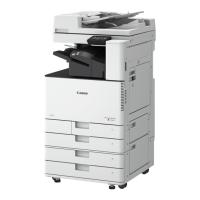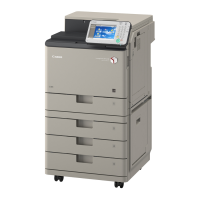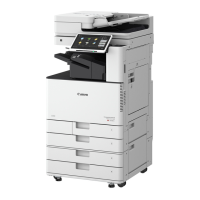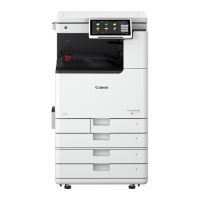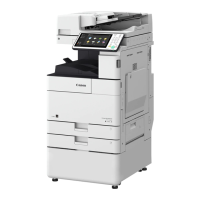Do you have a question about the Canon imageRUNNER C3025 and is the answer not in the manual?
Essential steps and checks before operating the machine.
Security measures to protect the machine from unauthorized access.
Step-by-step guide for initial machine setup via on-screen instructions.
Procedures to set the machine's date and time for accurate referencing.
Guidance on connecting the machine to a wired or wireless local area network.
Install necessary drivers and software for the machine on your computer.
Configure fax settings, including receive mode and unit information.
Configure network settings for sending scanned originals via email, shared folders, or FTP.
Identifies and explains the machine's exterior, interior, and operation panel components.
Step-by-step instructions on how to power on the machine.
Guide to operating the machine's display and keys for configuration and tasks.
Procedures for logging into the machine when Department ID or System Manager IDs are enabled.
Instructions on how to place originals on the platen glass or in the feeder.
Guidance on loading paper into the paper drawer and multi-purpose tray.
Instructions to match paper settings with the loaded paper for correct printing.
Procedures for registering fax and scan destinations in the Address Book.
Overview of the basic copy screen elements and settings.
Explains the fundamental procedure for copying an original document.
Detailed settings to improve brightness, erase shadows, and adjust copy quality.
Explains functions like N on 1 copying, collating, stapling, and ID card copies.
Overview of the screen and features available when sending faxes.
Explains the fundamental procedure for sending an original document via fax.
Describes methods for receiving faxes and setting up the machine.
Covers recalling settings, manual sending, and saving sent fax copies.
Instructions for sending fax documents directly from your computer.
Details on sending and receiving faxes over the Internet using TIFF attachments.
Steps to print documents from your computer using the printer driver.
Procedures to cancel printing from your computer or the operation panel.
How to check current print statuses and logs for printed documents.
Describes printing secured documents with a PIN and printing from USB memory.
Information on connecting and using mobile devices like smartphones and tablets.
Overview of the screen and options for initiating scan operations.
Covers scanning and saving to computer, USB, or sending via email/FTP.
Adjustments for density and brightness to achieve clearer scan image quality.
Features for enhancing security, balancing file size/image quality, and recalling settings.
Scanning documents from a computer using MF Scan Utility or other applications.
Information on connecting and using mobile devices like smartphones and tablets.
Details on using applications for printing, scanning, and other operations.
Settings and procedures for using AirPrint with Apple devices for printing.
Protect the machine from unauthorized access by setting user privileges.
Implement features to enhance network security against threats like sniffing and tampering.
Limit machine capabilities to prevent misuse, such as restricting access or functions.
Use digital signatures and encryption to prevent document leakage or tampering.
Operate the machine remotely via a web browser to check status and change settings.
Procedures for updating the machine's firmware via the internet or a computer.
Restore machine settings or specific data to factory defaults.
Actions to take when suspecting machine malfunctions or common issues.
Guide to understanding and resolving error messages and codes displayed on the machine.
Step-by-step instructions on how to remove jammed paper from various locations.
Procedures for clearing staple jams in optional finishing equipment.
Tips for leveraging machine features based on intended use and environment.
Technical specifications for the main unit and optional equipment.
Information on compatible operating systems and network environments.
Information on available optional equipment to expand machine functionality.
Lists and describes the included manuals and how to use them.
Essential steps and checks before operating the machine.
Security measures to protect the machine from unauthorized access.
Step-by-step guide for initial machine setup via on-screen instructions.
Procedures to set the machine's date and time for accurate referencing.
Guidance on connecting the machine to a wired or wireless local area network.
Install necessary drivers and software for the machine on your computer.
Configure fax settings, including receive mode and unit information.
Configure network settings for sending scanned originals via email, shared folders, or FTP.
Identifies and explains the machine's exterior, interior, and operation panel components.
Step-by-step instructions on how to power on the machine.
Guide to operating the machine's display and keys for configuration and tasks.
Procedures for logging into the machine when Department ID or System Manager IDs are enabled.
Instructions on how to place originals on the platen glass or in the feeder.
Guidance on loading paper into the paper drawer and multi-purpose tray.
Instructions to match paper settings with the loaded paper for correct printing.
Procedures for registering fax and scan destinations in the Address Book.
Overview of the basic copy screen elements and settings.
Explains the fundamental procedure for copying an original document.
Detailed settings to improve brightness, erase shadows, and adjust copy quality.
Explains functions like N on 1 copying, collating, stapling, and ID card copies.
Overview of the screen and features available when sending faxes.
Explains the fundamental procedure for sending an original document via fax.
Describes methods for receiving faxes and setting up the machine.
Covers recalling settings, manual sending, and saving sent fax copies.
Instructions for sending fax documents directly from your computer.
Details on sending and receiving faxes over the Internet using TIFF attachments.
Steps to print documents from your computer using the printer driver.
Procedures to cancel printing from your computer or the operation panel.
How to check current print statuses and logs for printed documents.
Describes printing secured documents with a PIN and printing from USB memory.
Information on connecting and using mobile devices like smartphones and tablets.
Overview of the screen and options for initiating scan operations.
Covers scanning and saving to computer, USB, or sending via email/FTP.
Adjustments for density and brightness to achieve clearer scan image quality.
Features for enhancing security, balancing file size/image quality, and recalling settings.
Scanning documents from a computer using MF Scan Utility or other applications.
Information on connecting and using mobile devices like smartphones and tablets.
Details on using applications for printing, scanning, and other operations.
Settings and procedures for using AirPrint with Apple devices for printing.
Protect the machine from unauthorized access by setting user privileges.
Implement features to enhance network security against threats like sniffing and tampering.
Limit machine capabilities to prevent misuse, such as restricting access or functions.
Use digital signatures and encryption to prevent document leakage or tampering.
Operate the machine remotely via a web browser to check status and change settings.
Procedures for updating the machine's firmware via the internet or a computer.
Restore machine settings or specific data to factory defaults.
Actions to take when suspecting machine malfunctions or common issues.
Guide to understanding and resolving error messages and codes displayed on the machine.
Step-by-step instructions on how to remove jammed paper from various locations.
Procedures for clearing staple jams in optional finishing equipment.
Tips for leveraging machine features based on intended use and environment.
Technical specifications for the main unit and optional equipment.
Information on compatible operating systems and network environments.
Information on available optional equipment to expand machine functionality.
Lists and describes the included manuals and how to use them.
| Print Technology | Laser |
|---|---|
| Print Resolution | 1200 x 1200 dpi |
| Monthly Duty Cycle | 50, 000 pages |
| Functions | Print, Copy, Scan, Send |
| Paper Input (Standard) | 550 sheets |
| Paper Output Capacity (Standard) | 250 sheets |
| Duplex Printing | Yes |
| Scan Resolution | 600 x 600 dpi |
| Copy Resolution | 600 x 600 dpi |
| Multiple Copy | Up to 999 copies |
| Power Source | 220-240V, 50/60Hz |
| Max Paper Size | A4 |
| Mobile Printing | Yes |
| Print Speed | 25 ppm |
| Scan Type | Flatbed, ADF |
| Copy Speed | 25 cpm |
| Paper Capacity | 550 sheets |
| Connectivity | USB, Ethernet |
| Display | 5-inch Touchscreen |
| Warm-up Time | 30 seconds |
| Memory | 2 GB |
| Interface | USB 2.0, Ethernet |
| Supported Media Types | Plain, Recycled, Color, Heavy, Bond, Label, Envelope |
| Supported Media Sizes | A4, A5, B5, Envelope |
| Supported Media Weights | 60-220 g/m² |
| Magnification | 25-400% |
| Power Consumption (Maximum) | 1.5 kW |
| First Print Out Time (Color) | 10.5 seconds |
